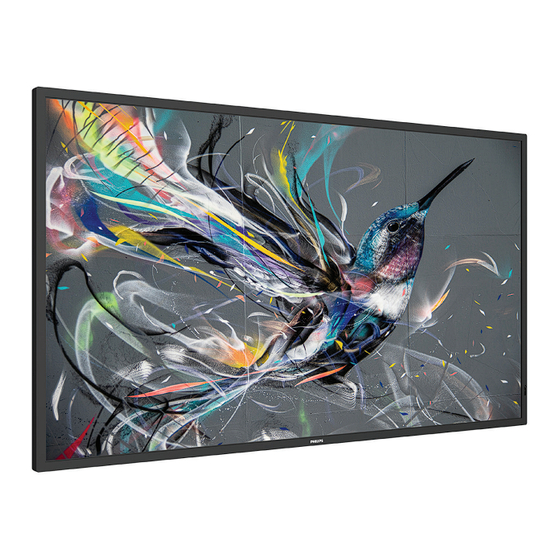
Summarization of Contents
Safety Information
Safety Precautions and Maintenance
General guidelines for safe operation and upkeep of the display unit.
Service, Stability, and Declarations
Service and Support Information
Details on contacting service centers for repairs or integration.
Stability Hazard and ESD Warnings
Alerts on device stability risks and electrostatic discharge effects.
EU Declaration of Conformity
States compliance with EU directives for EMC, low-voltage, and RoHS.
Regulatory Compliance and EMF
Polish Certification and EMF
Outlines Polish electrical safety and general EMF compliance.
International Compliance and Disposal
RoHS and Disposal Guidelines
Compliance statements for Turkey/Ukraine and guidance on product disposal.
Waste Disposal and Energy Star
WEEE and E-Waste Management
Guidelines for proper disposal of electronic equipment in EU and India.
ENERGY STAR Qualification
Information on the product's energy efficiency certification.
2. Unpacking and Installation
2.1. Unpacking Guide
Procedures for safely unpacking the product and verifying contents.
Mounting Procedures
2.4. Wall Mounting
Steps for attaching the display to a wall, including VESA specs.
2.4.1. VESA Grid Specs
Lists VESA mounting hole dimensions for different models.
Portrait Mounting and Logo Removal
2.5. Portrait Orientation Mounting
Instructions for installing the display in a vertical orientation.
2.5.1. Logo Removal Procedure
Steps on how to carefully remove the Philips logo sticker.
3. Parts and Functions
3.1. Control Panel Overview
Identifies and explains the buttons on the display's physical control panel.
3.3. Remote Control
3.3.1. General Remote Functions
Explains the basic operation of each button on the remote control.
Remote Control ID and Setup
3.3.2. ID Remote Control Setup
Guides on setting the remote control's ID for multi-display management.
Remote Control Usage and Maintenance
3.3.3. Battery Installation
Instructions for inserting or replacing batteries in the remote control.
3.3.4. Remote Control Handling
Precautions for handling the remote control to prevent damage.
3.3.5. Remote Control Range
Specifies the effective distance and angle for remote control use.
Peripheral Covers Installation
3.4. USB Cover Installation
Steps to install the cover for the USB stick and ports.
3.5. AC Switch Cover Installation
Steps to install the cover for the AC power switch.
4. Connecting External Equipment
4.1. Connecting DVD/VCR/VCD
How to connect legacy video sources using HDMI.
4.2. Connecting a PC
Instructions for connecting a computer via DVI or HDMI inputs.
Advanced Connectivity Options
4.3. Daisy-chain Configuration
Steps to link multiple displays for video wall setups using RS232.
4.4. IR Connection
How to connect an external IR receiver for remote control.
4.5. IR Pass-through
Enables IR signals to pass through to control other devices.
Network Connection and USB Operation
4.6. Wire-connecting to Network
Steps to establish a wired network connection for the display.
5.1. Play USB Multimedia
How to connect a USB device and play media files.
OSD Menu Navigation and Overview
6.1. Navigating the OSD Menu
Methods for navigating OSD menus using remote or display buttons.
6.2. OSD Menu Overview
Provides a general structure of the OSD menu system.
Picture and Screen Menu Settings
6.2.1. Picture Menu Options
Explains settings like Brightness, Contrast, Sharpness, and Color.
6.2.2. Screen Menu Options
Covers H/V position, Clock, Clock Phase, and Zoom mode settings.
Audio and Tiling Menu Settings
6.2.3. Audio Menu Options
Settings for Balance, Treble, Bass, Volume, and Audio Output.
6.2.4. Tiling Menu Setup
Configuration for creating large screen matrices using multiple displays.
Network and Configuration Menu
6.2.5. Network Menu Options
Settings for DHCP, IP address, Netmask, and Gateway.
6.2.6. Configuration Menu Options
Includes switch-on state, network ports, and boot source selection.
Advanced Display Options (Option Menu)
6.2.7. Option Menu Settings
Explains language, auto signal detection, date/time, and schedule functions.
Advanced Features (HDMI, IR, Power Save)
HDMI EDID and IR Control
Settings for HDMI signal compatibility and remote control operation modes.
Keypad Control and Power Save
Options to lock the keypad and manage power saving modes.
USB Autoplay and Playlist Management
USB Autoplay and Off Timer
Settings for automatic USB media playback and timed power-off.
USB Play List Management
How to create and manage playlists for USB media playback.
USB Cloning, Firmware, and Resets
USB Cloning and OPS
Options for copying settings and configuring the OPS module.
Firmware Update and Resets
Procedures for updating firmware and performing factory resets.
7. Supported Media Formats
USB Multimedia Formats
Details supported video, audio, and photo file types and specifications.
HDCP Support Table
Information on High-bandwidth Digital Content Protection compatibility.
8. Input Mode and Timing
Timing Support List
Table of supported display resolutions and refresh rates.
9. Pixel Defect Policy
9.1. Pixels and Sub-Pixels
Defines pixels and sub-pixels and how they form an image.
9.2. Pixel Defect Definitions
Explains types of pixel defects and defines a "dot" defect.
9.3. Bright Dot Defects
Examples and descriptions of pixels that are always lit.
Pixel Defects and Mura
9.4. Dark Dot Defects
Examples and descriptions of pixels that are always dark.
9.5. Pixel Defect Proximity
Tolerances for the spacing of pixel defects.
9.6. Pixel Defect Tolerances
Acceptable levels for bright and dark dot defects.
9.7. MURA Explanation
Describes Mura, its causes, and that it is not repairable.
10. Cleaning and Troubleshooting
10.1. Cleaning Procedures
Guidelines for safely cleaning the display's front panel and cabinet.
Troubleshooting Common Issues
10.2. Troubleshooting Solutions
A table detailing common issues, their causes, and remedies.
11. Technical Specifications
Display Specifications
Lists screen size, resolution, brightness, contrast, and viewing angles.
Input/Output Terminals
Details the types and specifications of available input and output ports.
General and Environmental Specifications
General Specifications
Includes power input, consumption, dimensions, weight, and EPREL data.
Environmental Conditions
Specifies operational and storage temperature, humidity, and altitude limits.
Warranty Policy
Limited Warranty Details
Explains coverage, what is included, and exclusions from the warranty.
Warranty Service and Period
Obtaining Warranty Service
Guidance on how to get warranty service and check user manuals first.
Warranty Period by Region
Lists the standard warranty duration for different geographical regions.















Need help?
Do you have a question about the Q Line 86BDL3650Q/00 and is the answer not in the manual?
Questions and answers